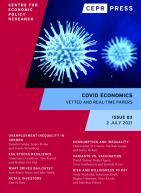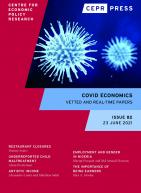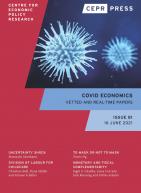
We offer a novel theoretical framework to study optimal vaccination policies. The key features of the model are that agents: 1) differ both in their potential exposure (x) to others and vulnerability (y) to severe illness, 2) exert negative externalities through interaction, and 3) can take voluntary preventative measures, for instance self-isolation. Our main result is a complete characterization of the second-best policy. Three striking features emerge. First, it is non-monotone – people with intermediate y are vaccinated more than those with either low or high y. Second, it exhibits an exposure premium among those who do not self-isolate – people with higher x require lower overall risk, xy, to be vaccinated. Third, for those who voluntarily self-isolate, it is invariant to y, depending only upon x. Numerical results demonstrate that policies vaccinating only the most vulnerable perform significantly worse than other simple heuristics, especially when supplies are limited.
Citation
Weiss, J and N Vellodi (2021), ‘Optimal Vaccine Policies: Spillovers and Incentives‘, COVID Economics 65, CEPR Press, Paris & London. https://cepr.org/publications/covid-economics-issue-65#392514_392941_390702
Are schools triggering the diffusion of the Covid-19? This question is at the core of an extensive debate about the social and long-run costs of stopping the economic activity and human capital accumulation from reducing the contagion. In principle, many confounding factors, such as climate, health system treatment, and other forms of restrictions, may impede disentangling the link between schooling and Covid-19 cases when focusing on a country or regional-level data. This work sheds light on the potential impact of school opening on the upsurge of contagion by combining a weekly panel of geocoded Covid-19 cases in Sicilian census areas with a unique set of school data. The identification of the effect takes advantage of both a spatial and time-variation in school opening, deriving by the flexibility in opening dates determined by a Regional Decree, and by the occurrence of a national referendum, which pulled a set of poll-station schools towards opening on the 24th of September. The analysis finds that census areas where schools opened before observed a significant and positive increase of Covid-19 cases between 1.5-2.9%. This result is consistent across several specifications, including accounting for several schools opening determinants, such as the number of temporary teachers, Covid-19 cases in August, and pupils with special needs. Besides, school opening increases non-linearly the number of instances in zones observing already some Covid-19 cases. Using the estimated coefficients, this paper also presents a prediction of Covid-19 cases with different school opening scenarios. Finally, an exploration of the heterogeneity at school and demographic levels, including class size and age, poses the basis for calibrated policies to control differential reopening.
Citation
Maida, C, G Maggio, M Battisti, A Kourtellos and E Amodio (2021), ‘Schools opening and Covid-19 diffusion: evidence from geolocalized microdata‘, COVID Economics 65, CEPR Press, Paris & London. https://cepr.org/publications/covid-economics-issue-65#392514_392941_390703
Though COVID vaccines are finally available, the rate at which they are administered is slow, and in the meantime the pandemic continues to claim about as many lives every day as the 9/11 tragedy. I estimate that with the promised rate of vaccinations, if no additional non-pharmaceutical interventions are implemented, 406 thousand additional lives will be lost and the future cost of the pandemic will reach $2.4 trillion, or 11% of GDP. Using a cost-benefit analysis, I assess whether it is optimal for the United States to follow the lead of many European countries and introduce a nation-wide lockdown. I find that a lockdown would be indeed optimal and, depending on the assumptions, it should last between two and four weeks and will generate a net benefit of up to $1.2 trillion.
Citation
Scherbina, A (2021), ‘Could the United States benefit from a lockdown? A cost-benefit analysis‘, COVID Economics 65, CEPR Press, Paris & London. https://cepr.org/publications/covid-economics-issue-65#392514_392941_390704
We aim to answer if superior performance by short sellers’ is generated by processing public information rather than by exploiting private information. To achieve this, we analyze if short sellers with healthcare expertise outperform in short selling of non-healthcare stocks compared to those with no healthcare expertise. Since we expect that any short sellers’ private information about healthcare stocks is unlikely to be material for non-healthcare stocks, we conclude that any observed outper-formance in non-healthcare stocks is more likely caused by processing public information. As an identification strategy, we interpret the outbreak of the Covid-19 pandemic as a treatment to short sellers with healthcare expertise. Our measures of healthcare expertise are based on pre-Covid-19 performance related to either holding or covering a short position in healthcare stocks. Using a unique German sample of daily short selling data, we find that treated short positions identified by general shorting (covering) outperformance are associated with lower 10-day CARs for non-healthcare stocks by an economically significant magnitude of 4.3 percent (7.2 percent). Robustness test rule out that our results are also driven by the use of private information or non information-based trading advantages such as better funding or lending ability of observed short sellers.
Citation
Strych, J, J Westerholm and L Schattmann (2021), ‘Information Processing Skills of Short Sellers: Empirical Evidence from the Covid-19 Pandemic‘, COVID Economics 65, CEPR Press, Paris & London. https://cepr.org/publications/covid-economics-issue-65#392514_392941_390705
We study the impact of the COVID-19 shock on the portfolio exposures of euro area investors. The analysis "looks-through" holdings of investment fund shares to first gauge euro area investors' full exposures to global debt securities and listed shares by sector at end-2019 and to subsequently analyse the portfolio shifts in the first and second quarter of 2020. We show important heterogeneous patterns across asset classes and sectors, but also across euro area less and more vulnerable countries. In particular, we find a broad-based rebalancing towards domestic sovereign debt at the expense of extra-euro area sovereigns, consistent with heightened home bias. These patterns were strongly driven by indirect holdings - via investment funds - especially for insurance companies and pension funds, but levelled off in the second quarter. On the contrary, for listed shares we find that euro area investors rebalanced away from domestic towards extra-euro area securities in both the first and the second quarter, which may be associated with better relative foreign stock market performance. Many of these shifts were only due to indirect holdings, corroborating the importance of investment funds in assessing investors' exposures via securities, in particular in times of large shocks. We also confirm this mechanism in an analysis focusing on the large-scale portfolio rebalancing observed between 2015 and 2017 during the ECB's Asset Purchase Programme.
Citation
Schmitz, M and D Carvalho (2021), ‘Shifts in the portfolio holdings of euro area investors in the midst of COVID-19: looking-through investment funds‘, COVID Economics 65, CEPR Press, Paris & London. https://cepr.org/publications/covid-economics-issue-65#392514_392941_390706
This research updates early studies on the intention to be vaccinated against the Covid-19 virus among a representative sample of adults in 6 European countries (France, Germany, Italy, Spain, Sweden, and the UK) and differentiated by groups of “acceptorsâ€, “refusersâ€, and “ hesitantâ€. The research relies on a set of traditional logistic and more complex classification techniques such as Neural Networks and Random Forest techniques to determine common predictors of vaccination preferences. The findings highlight that socio-demographics are not a reliable measure of vaccination propensity, after one controls for different risk perceptions, and illustrate the key role of institutional and peer trust for vaccination success. Policymakers must build vaccine promotion techniques differentiated according to “acceptorsâ€, “refusersâ€, and “ hesitantâ€, while restoring much larger trust in their actions upfront since the pandemics if one wishes the vaccination coverage to close part of the gap to the level of herd immunity.
Citation
Żyszkiewicz, M, D Reykowska, K Peters, R Ohme, M Cincera and J Bughin (2021), ‘Make it or break it: Vaccination intent at the time of Covid-19‘, COVID Economics 65, CEPR Press, Paris & London. https://cepr.org/publications/covid-economics-issue-65#392514_392941_390707


Covid Economics - Issue 82
- Restaurant Closures during the Pandemic: A Descriptive Analysis
- Underreporting Child Maltreatment during the Pandemic: Evidence from Colorado
- Covid-19 impact on Artistic Income
- COVID-19, Employment, and Gender: Evidence from Nigeria
- The Importance of Being Earners: Modelling the Implications of Changes to Welfare Contributions on Macroeconomic Recovery
